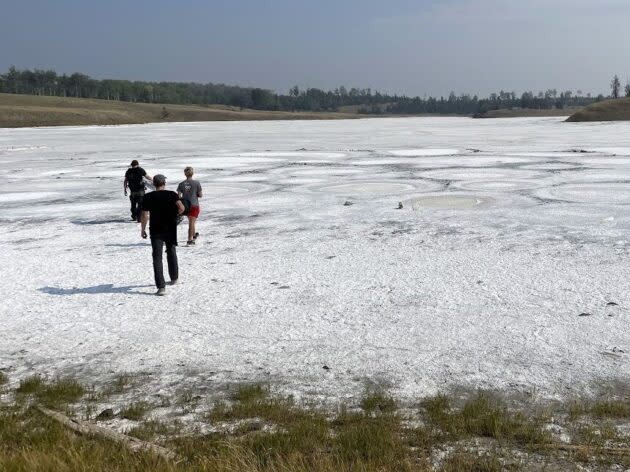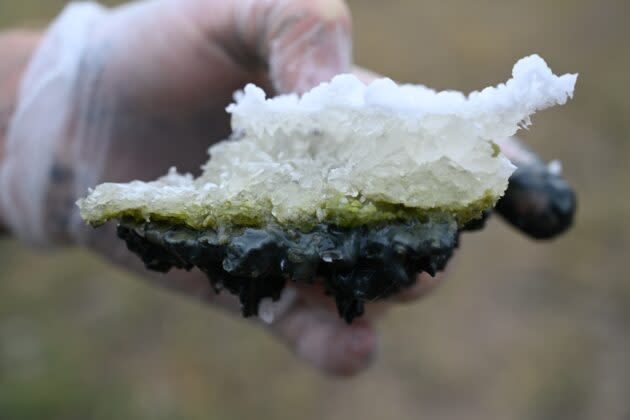Scientists go to Canada to study the kind of lake where they say life may have arisen

Several years ago, scientists at the University of Washington theorized that key ingredients for life could have built up billions of years ago in special kinds of environments known as soda lakes.
At the time, their hypothesis was based on previously published research, computer modeling and lab experiments. But now the same scientists say they’ve found a shallow lake that just might fit the requirements — and it happens to be just a few hundred miles north of their home base in Seattle.
Their findings, focusing on Last Chance Lake in British Columbia, were published this month in Communications Earth & Environment, an open-access, peer-reviewed scientific journal.
Last Chance Lake is special for several reasons: First of all, it’s definitely a soda lake — that is, a lake where chemical reactions between the lake’s water and the underlying volcanic rocks give rise to high levels of dissolved sodium and carbonate, similar to dissolved baking soda.
Soda lakes can also have high levels of dissolved phosphate. That’s important, because phosphate is an essential building block for DNA and RNA. It’s also a key component of cell membranes. But in order for phosphate to become incorporated into the molecules of life, it has to be present in concentrations that are up to a million times higher than the levels typically found in rivers, lakes or the ocean.
The lab study published in 2019 suggested that under the right conditions, phosphate concentrations could reach the required level in soda lakes.
“I think these soda lakes provide an answer to the phosphate problem,” David Catling, a UW professor of Earth and space sciences who was an author of the 2019 study as well as the newly published work, said in a news release. “Our answer is hopeful: This environment should occur on the early Earth, and probably on other planets, because it’s just a natural outcome of the way that planetary surfaces are made, and how water chemistry works.”
Catling and his colleagues identified Last Chance Lake as having a good chance of solving the “phosphate problem” based on a nearly 30-year-old research paper that referenced the lake’s extraordinarily high phosphate levels.
The lake is only about a foot deep. Dry, windy conditions on British Columbia’s Cariboo Plateau promote evaporation to keep water levels low while concentrating levels of the lake’s dissolved compounds. By summer’s end, the lake’s water has almost completely evaporated, leaving a murky, muddy mix with a salty crust on top.

“You have this seemingly dry salt flat, but there are nooks and crannies. And between the salt and the sediment there are little pockets of water that are really high in dissolved phosphate,” said lead study author Sebastian Haas, a postdoctoral researcher at UW. “What we wanted to understand was why and when could this happen on the ancient Earth, in order to provide a cradle for the origin of life.”
Researchers collected samples of water, lake sediment and salt crust during three visits to the lake in 2021 and 2022. In most lakes, calcium combines with phosphate to form calcium phosphate, a substance that turns up in milk, bones and tooth enamel. But at Last Chance Lake, the calcium instead combines with carbonate and magnesium to form a mineral called dolomite. That leaves the dissolved phosphate free to rise to concentrations far above typical levels.
Further analysis addressed another question about Last Chance Lake: Why aren’t the organisms that are typically found in lakes taking advantage of all that phosphate?
To find the answer, the research team looked at a nearby body of water called Goodenough Lake. They saw that cyanobacteria in Goodenough Lake were indeed consuming the phosphate and providing natural fertilizer for other forms of life. In contrast, the salt levels in Last Chance Lake were too high for life to gain much of a foothold there.
Places like Last Chance Lake could provide more chances for astrobiologists to test out their hypotheses as they learn more about potentially habitable environments in places ranging from Mars, Europa and Enceladus in our own solar system to Earthlike worlds in far-off planetary systems.
“These new findings will help inform origin-of-life researchers who are either replicating these reactions in the lab or are looking for potentially habitable environments on other planets,” Catling said.
Authors of the study published by Communications Earth & Environment, “Biogeochemical Explanations for the World’s Most Phosphate-Rich Lake, an Origin-of-Life Analog,” are Haas, Catling and UW graduate student Kimberly Poppy Sinclair. Graduate students with the UW Astrobiology Program also assisted with sample collection. The research was funded by the Simons Foundation.
More from GeekWire:
Washington governor calls for $10M in funding for university-led clean energy institute
Researchers take a freeze-frame reading of electrons energized in a stream of water
Scientists are using AI to study bee behavior, zebra movement, and insects on treadmills
California company breaks ground on Washington’s first commercial sustainable aviation fuel plant
